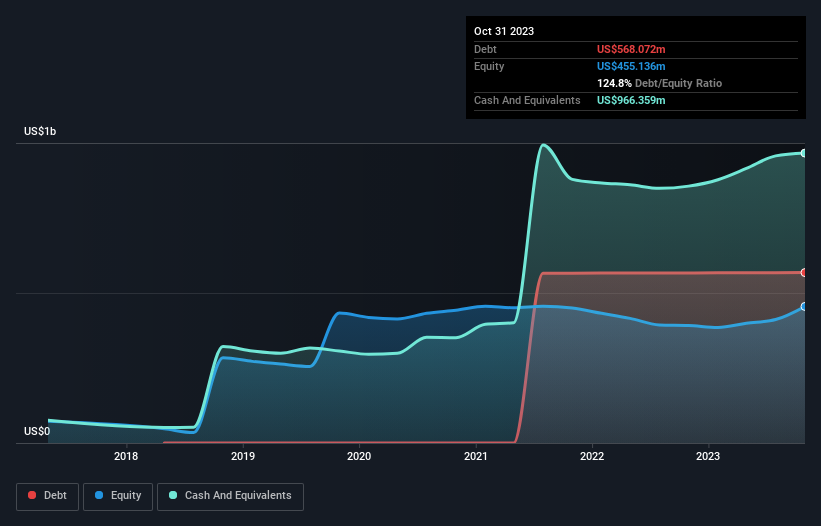
Howard Marks put it nicely when he said that, rather than worrying about share price volatility, 'The possibility of permanent loss is the risk I worry about... and every practical investor I know worries about.' So it might be obvious that you need to consider debt, when you think about how risky any given stock is, because too much debt can sink a company. We can see that Elastic N.V. (NYSE:ESTC) does use debt in its business. But should shareholders be worried about its use of debt?
When Is Debt A Problem?
Debt assists a business until the business has trouble paying it off, either with new capital or with free cash flow. In the worst case scenario, a company can go bankrupt if it cannot pay its creditors. However, a more usual (but still expensive) situation is where a company must dilute shareholders at a cheap share price simply to get debt under control. By replacing dilution, though, debt can be an extremely good tool for businesses that need capital to invest in growth at high rates of return. The first thing to do when considering how much debt a business uses is to look at its cash and debt together.
See our latest analysis for Elastic
What Is Elastic's Net Debt?
The chart below, which you can click on for greater detail, shows that Elastic had US$568.1m in debt in October 2023; about the same as the year before. But it also has US$966.4m in cash to offset that, meaning it has US$398.3m net cash.

How Strong Is Elastic's Balance Sheet?
We can see from the most recent balance sheet that Elastic had liabilities of US$687.2m falling due within a year, and liabilities of US$615.5m due beyond that. On the other hand, it had cash of US$966.4m and US$232.3m worth of receivables due within a year. So its liabilities outweigh the sum of its cash and (near-term) receivables by US$104.1m.
This state of affairs indicates that Elastic's balance sheet looks quite solid, as its total liabilities are just about equal to its liquid assets. So while it's hard to imagine that the US$12.2b company is struggling for cash, we still think it's worth monitoring its balance sheet. Despite its noteworthy liabilities, Elastic boasts net cash, so it's fair to say it does not have a heavy debt load! When analysing debt levels, the balance sheet is the obvious place to start. But it is future earnings, more than anything, that will determine Elastic's ability to maintain a healthy balance sheet going forward. So if you're focused on the future you can check out this free report showing analyst profit forecasts.
In the last year Elastic wasn't profitable at an EBIT level, but managed to grow its revenue by 19%, to US$1.2b. That rate of growth is a bit slow for our taste, but it takes all types to make a world.
So How Risky Is Elastic?
Although Elastic had an earnings before interest and tax (EBIT) loss over the last twelve months, it generated positive free cash flow of US$67m. So although it is loss-making, it doesn't seem to have too much near-term balance sheet risk, keeping in mind the net cash. With revenue growth uninspiring, we'd really need to see some positive EBIT before mustering much enthusiasm for this business. When analysing debt levels, the balance sheet is the obvious place to start. But ultimately, every company can contain risks that exist outside of the balance sheet. For example, we've discovered 4 warning signs for Elastic that you should be aware of before investing here.
If, after all that, you're more interested in a fast growing company with a rock-solid balance sheet, then check out our list of net cash growth stocks without delay.
Valuation is complex, but we're here to simplify it.
Discover if Elastic might be undervalued or overvalued with our detailed analysis, featuring fair value estimates, potential risks, dividends, insider trades, and its financial condition.
Access Free AnalysisHave feedback on this article? Concerned about the content? Get in touch with us directly. Alternatively, email editorial-team (at) simplywallst.com.
This article by Simply Wall St is general in nature. We provide commentary based on historical data and analyst forecasts only using an unbiased methodology and our articles are not intended to be financial advice. It does not constitute a recommendation to buy or sell any stock, and does not take account of your objectives, or your financial situation. We aim to bring you long-term focused analysis driven by fundamental data. Note that our analysis may not factor in the latest price-sensitive company announcements or qualitative material. Simply Wall St has no position in any stocks mentioned.
About NYSE:ESTC
Elastic
A search artificial intelligence (AI) company, delivers hosted and managed solutions designed to run in hybrid, public or private clouds, and multi-cloud environments in the United States and internationally.
Good value with adequate balance sheet.
Similar Companies
Market Insights
Community Narratives


